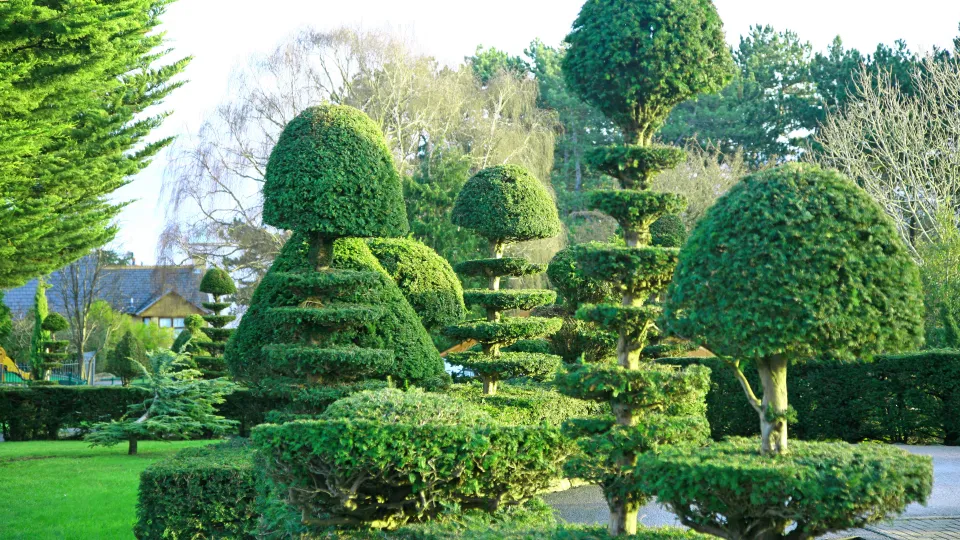
Shaping Small Trees for Symmetry
Enhancing Landscape Harmony with Tree Structure
In any well-designed landscape, balance and proportion play an essential role. Structuring small trees for visual symmetry is a specialized service that brings coherence and elegance to outdoor spaces. This practice involves the careful pruning, guiding, and maintenance of young or small trees to develop even growth, consistent form, and pleasing alignment. The goal is not just aesthetic but also functional, supporting the long-term health and integration of the tree within the garden’s design.
Proper tree structuring enhances curb appeal, creates focal points, and adds architectural rhythm to both formal and informal landscapes. Whether used in symmetrical rows, flanking pathways, or standing alone as sculptural accents, symmetrical small trees bring a sense of order and calm.
Selecting Trees for Structural Beauty
Not every tree is suited for formal shaping. Our work begins with identifying tree species that respond well to structural pruning and can maintain visual consistency over time. These typically include:
- Ornamental trees like Japanese maple, dogwood, and cherry.
- Columnar and rounded species such as hornbeam, linden, and certain magnolias.
- Evergreens like dwarf spruce and cypress for year-round symmetry.
Each tree is evaluated for growth rate, branch structure, leaf density, and adaptability to trimming. The goal is to choose species that can sustain a defined shape while still developing naturally and healthily.
Pruning for Shape and Proportion
Structuring a tree begins with precision pruning techniques that shape the overall form while encouraging balanced growth. This includes:
- Canopy thinning , to reduce weight and improve light penetration.
- Leader selection , to define a single dominant trunk and symmetrical branching.
- Crown lifting , to elevate the lowest branches for a clean and defined silhouette.
- Lateral branch trimming , ensuring that both sides of the tree develop evenly in width and height.
Each cut is made with care to guide the tree’s growth rather than restrict it. Clean, strategic pruning reduces stress on the plant and promotes a strong, natural shape that remains symmetrical even as the tree matures.
Creating Architectural Impact
Small trees can act as living architectural elements. When structured correctly, they contribute to the geometric flow of gardens and outdoor spaces, echoing the lines of fences, buildings, pathways, and plant beds. In formal gardens, symmetrical trees define visual axes and frame entry points. In more relaxed settings, they offer visual anchors that bring cohesion to loosely arranged plants.
Strategically placed trees also improve space usage. For example, evenly spaced and pruned trees can provide dappled shade for seating areas, create privacy screens without blocking views, or divide a yard into distinct zones for function and relaxation.
Seasonal Maintenance and Long-Term Structure
Shaping a small tree is not a one-time task. It is a process of ongoing maintenance that evolves with the tree’s natural development. Seasonal adjustments are necessary to preserve form and correct any imbalances caused by weather, growth spurts, or minor damages.
Regular follow-up care includes removing suckers, trimming uneven growth, monitoring branch angles, and adjusting for symmetry lost during storms or uneven sun exposure. With consistent attention, a small tree can be guided into a stable and symmetrical form that requires less intensive care over time.
Balancing Aesthetics and Plant Health
While symmetry is the visual goal, tree health is always the priority. Every action taken during the structuring process is based on botanical knowledge and growth habits. We never force a shape at the expense of the tree’s wellbeing. Instead, we guide growth in ways that respect the natural rhythm of the plant.
By promoting proper air circulation, sunlight distribution, and structural strength, structured trees are not only beautiful but also resilient. This balance of art and science ensures that they continue to thrive year after year.
The Subtle Power of Symmetry
A well-structured small tree can transform a garden. It may not demand attention with loud colors or dramatic blooms, but its form quietly conveys discipline, intention, and care. Symmetry in trees brings peace to the eye and stability to the design — qualities that enhance both traditional and contemporary landscapes.
Whether framing a walkway, enhancing a courtyard, or accenting a flower bed, symmetrically shaped small trees contribute to the overall beauty and flow of outdoor spaces. Through expert structuring, these trees become enduring symbols of order, balance, and refined natural design.